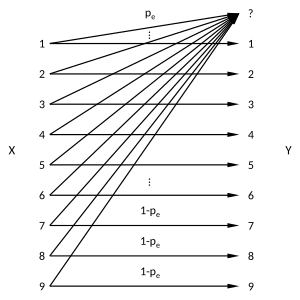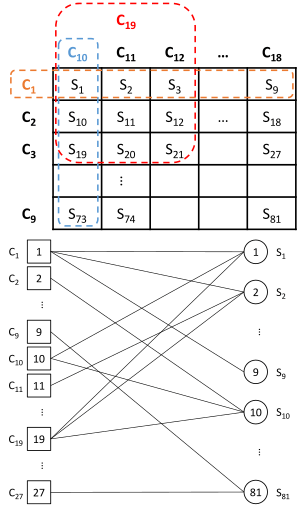Sudoku code facts for kids
Sudoku codes are a cool idea that mixes sudoku puzzles with a way to fix errors in messages. Imagine you're sending a secret message, but some parts might get lost. Sudoku codes help you rebuild the missing parts!
They are a type of "forward error correcting code." This means they add extra information to a message before it's sent. This extra info helps the receiver fix any parts that go missing. Think of it like sending a solved Sudoku puzzle. If some numbers disappear, the rules of Sudoku can help you figure out what they were.
These codes are mostly for research right now, not for everyday use. Scientists are still learning how well they work and how much information they can carry.
Contents
How Sudoku Codes Work
When you send a message using Sudoku codes, you're basically sending a complete, solved Sudoku puzzle. If some numbers get lost or "erased" during sending, the person receiving the message gets a puzzle with empty squares.
The amazing part is that the receiver can use the normal Sudoku rules to fill in those missing numbers. This is like "decoding" the message. It's similar to how you solve a Sudoku puzzle when you have some numbers missing.
Scientists can even use special computer methods, like "belief propagation," which are also used for other types of codes, to help solve these Sudoku puzzles and recover the lost information.
What is an Erasure Channel?
Imagine a special path your message travels on. This path is called an "erasure channel." On this path, a number either arrives perfectly, or it disappears completely. It never changes into the wrong number. It just vanishes.
Let's say you send a small 3x3 Sudoku code. If 5 out of 9 numbers get erased, the decoder can still figure out the whole puzzle! This shows how powerful Sudoku rules can be for fixing missing information.
Sudoku numbers (like 1 to 9) are not just simple "on" or "off" signals like in a computer. If you send them as groups of information, this channel is like a "packet erasure channel." This means whole chunks of data might go missing.
Understanding Sudoku Puzzles
A Sudoku is a grid, usually 9x9, that you fill with numbers. The main rules are:
- Each row must have every number (from 1 to 9) exactly once.
- Each column must have every number (from 1 to 9) exactly once.
- Each smaller 3x3 box (called a sub-grid) must have every number (from 1 to 9) exactly once.
When you start a Sudoku puzzle, some numbers are already filled in. There's only one correct way to finish the puzzle.
There are also different kinds of Sudoku puzzles. Some use diagonal lines instead of square sub-grids. These "diagonal Sudokus" can be different sizes, not just sizes like 4x4 or 9x9.
Sudoku codes are "non-linear." This means you can't just combine two solved Sudoku puzzles in a simple way to get another valid one. Also, unlike some other codes, a Sudoku puzzle can never be all zeros, because it needs distinct numbers in each row, column, and box.
Decoding with Belief Propagation
There are many ways to solve Sudoku puzzles, and these methods can also be used to "decode" Sudoku codes. Some methods are very specific to Sudoku, like "dancing links."
A very important method for decoding is called "belief propagation." This method is also used for other complex codes, like "low-density parity-check codes" (LDPC codes). By studying how belief propagation works for Sudoku codes, scientists can learn more about how to decode other difficult codes.
Imagine the Sudoku grid as a network. Each cell where you put a number is connected to the rules (the row, column, and 3x3 box it belongs to). This network is called a "tanner graph." Belief propagation works by sending "messages" or "beliefs" between the cells and the rules.
- If a cell has a number, it tells its connected rules what that number is.
- If a rule sees a number in one of its cells, it tells the other cells in its group that they cannot use that number.
This process goes back and forth, narrowing down the possibilities for each empty cell until the puzzle is solved. It's like how you might solve a Sudoku by eliminating numbers that can't fit in a certain square.
Encoding Sudoku Codes
"Encoding" means turning your original message into a Sudoku code that can be sent. The goal is to make the message strong enough to survive errors during transmission.
For example, a standard 9x9 Sudoku puzzle holds about 72.5 bits of information. A "bit" is like a tiny piece of information, like an "on" or "off" switch. So, one Sudoku puzzle can carry about as much information as 72 coin tosses.
A simple way to encode a message into a Sudoku is:
- Start with an empty Sudoku grid.
- Go cell by cell, filling in numbers.
- For each cell, figure out all the numbers that are allowed there based on Sudoku rules.
- Then, use parts of your original message to pick one of the allowed numbers for that cell.
- Continue until the whole grid is filled.
For a 4x4 Sudoku, the first cell can be any of 4 numbers. Once you pick one, that number can't be used in that row, column, or 2x2 box again. So, the next cell might only have 3 choices, then 2, and so on. This process fills the grid and turns your message into a Sudoku code.
Performance of Sudoku Codes
Figuring out how much information a Sudoku code can carry, called its "rate," is tricky. For a 9x9 Sudoku, the average rate is about 0.28. This means that for every 100 symbols you send, about 28 of them carry new information, and the rest are for fixing errors.
There are a huge number of possible solved 9x9 Sudoku grids: over 6.67 quintillion! This large number means they can hold a good amount of information.
Scientists have found that you need at least 17 numbers filled in a Sudoku puzzle to guarantee it has only one unique solution. If fewer than 17 numbers are given, there might be more than one way to solve it.





